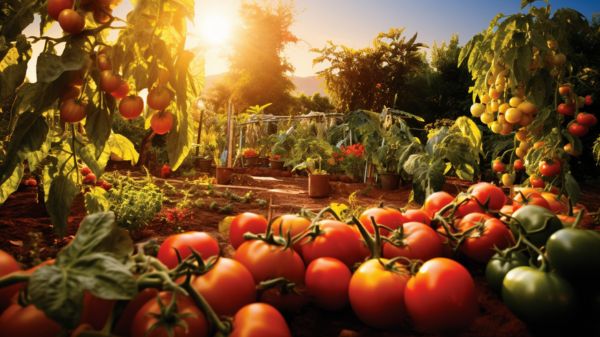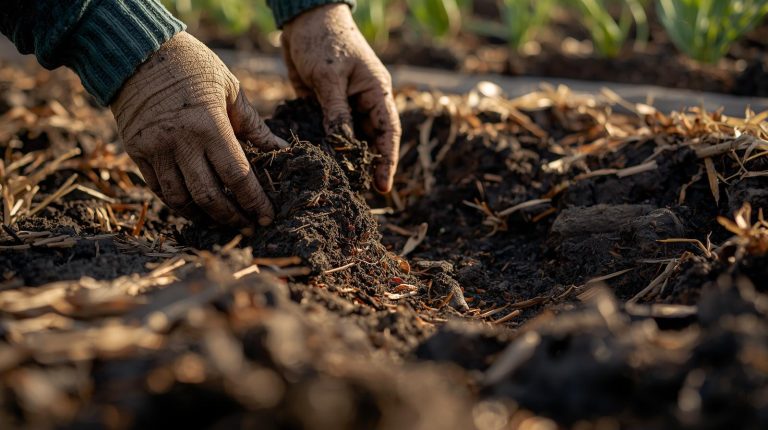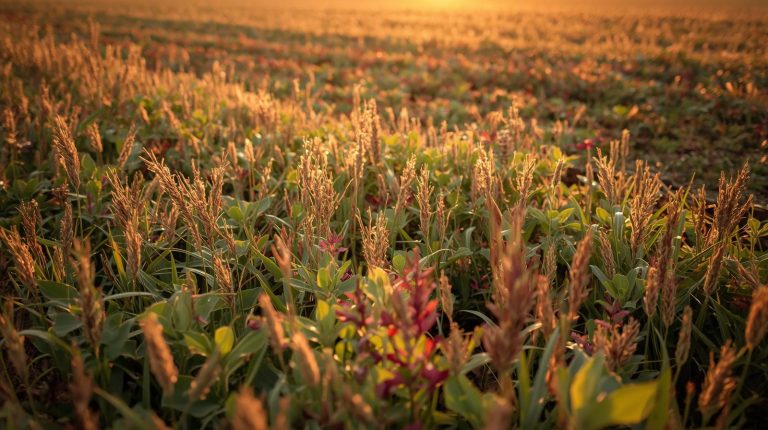Are you interested in composting but not sure where to start? Look no further! We’ve uncovered the top 9 beginner-friendly composting methods just for you.
In this article, we’ll unveil the secrets of traditional composting, vermicomposting, bokashi composting, and more. With our detailed and practical advice, you’ll be able to create nutrient-rich soil for your garden in no time.
So join us on this composting journey and become part of a community that values sustainable living. Let’s get started!
Traditional Composting
One of the most popular and effective beginner-friendly composting methods that we recommend is traditional composting. Traditional composting involves the natural decomposition of organic materials to create nutrient-rich compost. It’s a simple and straightforward process that anyone can do in their own backyard.
To start, gather your organic waste such as fruit and vegetable scraps, coffee grounds, and yard trimmings. Layer these materials with dry carbon-rich materials like leaves or straw. Make sure to keep the pile moist and turn it regularly to allow for proper aeration.
Over time, the materials will break down and transform into rich, dark compost that can be used to nourish your plants and improve soil health. Traditional composting is a cost-effective and environmentally friendly way to reduce waste and create valuable resources for your garden.
Vermicomposting
Let’s talk about vermicomposting, a method of composting that involves using worms to break down organic waste.
Vermicomposting has numerous benefits. First, it leads to faster decomposition of the waste compared to traditional composting methods. This is because worms have the ability to consume and break down organic matter at a quicker pace.
Additionally, vermicomposting produces compost with a higher nutrient content. Worms digest the waste and excrete nutrient-rich castings, which make for excellent fertilizer for plants. This nutrient-dense compost can greatly enhance the health and growth of our garden plants.
One of the advantages of vermicomposting is that it can be done indoors or in small spaces. This makes it a viable option for people living in apartments, urban areas, or areas with limited outdoor space. With a small vermicomposting bin or worm farm, we can easily manage our organic waste and produce compost without the need for a large backyard or garden.
Worms for Composting
To begin vermicomposting, we recommend gathering the necessary materials and setting up a worm bin. Vermicomposting, also known as worm composting, is a great method for beginners to transform their kitchen scraps into nutrient-rich worm castings. Here are four key items you’ll need to get started:
- Worms: Redworms, also called red wigglers or Eisenia fetida, are the best worms for composting. They thrive in organic waste and produce high-quality castings.
- Worm bin: A worm bin can be as simple as a plastic container with holes for aeration and drainage. It should be large enough to accommodate your kitchen scraps and the number of worms you have.
- Bedding material: Shredded newspaper or cardboard make excellent bedding materials for the worms. Avoid glossy paper or colored ink.
- Food scraps: Worms love fruit and vegetable scraps, coffee grounds, tea bags, and crushed eggshells. Avoid adding meat, dairy, or oily foods to prevent odor and attract pests.
Benefits of Vermicomposting
Now let’s explore the benefits of vermicomposting, a method that offers numerous advantages for both the environment and gardeners alike.
Vermicomposting, also known as worm composting, utilizes the natural process of worms breaking down organic waste materials to create nutrient-rich compost.
One of the key benefits of vermicomposting is its ability to reduce waste. By composting kitchen scraps and other organic materials, we can divert them from landfills, where they’d contribute to harmful greenhouse gas emissions.
Vermicomposting also produces high-quality compost that enriches the soil, improves plant growth, and enhances overall garden health.
Additionally, vermicomposting is relatively easy to start. All you need is a suitable container, bedding material, and a population of red worms. By providing them with the right conditions, such as maintaining proper moisture and temperature levels, you can create a thriving vermicomposting system that benefits both your garden and the environment.
Bokashi Composting
We frequently use the bokashi composting method because it allows us to actively participate in the decomposition process. Bokashi composting involves fermenting kitchen scraps using a special mix of beneficial microorganisms called EM or Effective Microorganisms.
Here are four bokashi composting techniques and their benefits:
- Layering Method: This technique involves layering kitchen waste with bokashi bran in an airtight container. It creates a rich compost that retains nutrients.
- Bokashi Bucket: Using a dedicated bokashi bucket, you can collect kitchen waste and sprinkle it with bokashi bran. The sealed container ensures anaerobic fermentation, reducing foul odors.
- Bokashi Compost Tea: By mixing bokashi bran with water, you can create a nutrient-rich liquid fertilizer for plants. It improves soil health and boosts plant growth.
- Direct Burying: Burying bokashi fermented waste directly in the soil speeds up decomposition, enriching the soil with organic matter.
Bokashi composting techniques offer numerous benefits, including reducing kitchen waste, producing nutrient-rich compost, and improving soil fertility.
Trench Composting
Continuing the exploration of composting methods, let’s delve into trench composting as another effective way to actively participate in the decomposition process.
Trench composting involves digging a trench in your garden or yard and filling it with organic waste. The benefits of trench composting are numerous. Firstly, it allows you to recycle your kitchen and garden waste directly into the soil, enriching it with nutrients.
Secondly, it eliminates the need for a compost bin or pile, making it a space-saving option for those with limited outdoor space. Lastly, trench composting helps improve soil structure and fertility, leading to healthier plants and a more vibrant garden.
The process is simple: dig a trench, fill it with organic waste, cover it with soil, and let nature do the rest. Over time, the waste will decompose, providing valuable nutrients to your plants.
Trench composting is an excellent method for beginners looking to make a positive impact on their gardens and the environment.
Composting With a DIY Bin
Moving on to the next one of beginner-friendly composting methods, let’s explore how to compost with a DIY bin. Composting with a DIY bin is a great option for those who want to create nutrient-rich soil in their own backyard. Here are four tips to help you get started:
- Choose the right bin: There are many DIY bin alternatives you can use, such as wooden pallets, plastic barrels, or even repurposed containers. Make sure the bin has good ventilation and is large enough to hold your compost materials.
- Layer your compost: Start with a layer of brown materials like leaves or shredded newspaper, followed by a layer of green materials such as kitchen scraps or grass clippings. Repeat these layers until the bin is full.
- Monitor moisture levels: Your compost should be moist but not soggy. If it’s too dry, add water; if it’s too wet, add more dry materials.
- Troubleshoot composting issues: If your compost smells bad, it may be too wet or not getting enough air. Turn the compost with a pitchfork to aerate it. If you see pests, cover your compost with a layer of straw or cardboard to deter them.
Composting with a DIY bin is a cost-effective and eco-friendly way to turn your kitchen scraps into valuable fertilizer for your plants. With these tips and troubleshooting techniques, you’ll be on your way to successful composting in no time. Happy composting!
Hot Composting
One popular method of beginner-friendly composting methods is hot composting, which involves using a concrete noun. Hot composting techniques rely on creating an active, high-temperature environment to speed up the decomposition process.
To achieve this, it’s important to use the best materials for hot composting. These include a balanced mix of green and brown materials, such as kitchen scraps, grass clippings, leaves, and shredded paper. The key is to maintain a proper ratio of carbon to nitrogen, aiming for roughly 30 parts carbon to 1 part nitrogen.
It’s also essential to turn the compost regularly to ensure proper aeration and distribution of heat. By following these hot composting techniques and using the right materials, you can create a thriving compost pile that breaks down quickly, producing nutrient-rich compost for your garden.
Leaf Mold Composting
When it comes to composting, leaf mold is another one of beginner-friendly composting methods that offers numerous benefits. Leaf mold is rich in nutrients and helps improve soil structure. Additionally, this composting method is relatively fast, with decomposition typically taking around six to twelve months.
Benefits of Leaf Mold
Leaf mold offers numerous benefits for beginner composters. Here are four reasons why leaf mold composting is beneficial for both our health and gardening endeavors:
- Improves soil structure: Leaf mold adds organic matter to the soil, enhancing its structure and promoting better drainage and aeration. This improves the soil’s ability to retain water and nutrients, creating an optimal environment for plant growth.
- Enriches the soil: The decomposed leaves in leaf mold release essential nutrients into the soil, providing a natural and sustainable source of nutrition for plants. This leads to healthier and more productive gardens, with increased yields and vibrant, lush foliage.
- Suppresses weeds: Applying a layer of leaf mold as mulch around plants helps suppress weed growth by smothering weed seeds and blocking their access to sunlight. This reduces the need for herbicides and manual weeding, making gardening more manageable for beginners.
- Promotes beneficial microbes: Leaf mold is rich in beneficial microorganisms that contribute to the overall health of the soil ecosystem. These microbes break down organic matter, releasing nutrients and improving soil fertility. Additionally, they help suppress harmful pathogens, reducing the risk of plant diseases.
Speed of Decomposition
To achieve optimal decomposition speed in leaf mold composting, we can employ various techniques. Factors affecting decomposition include the size of the leaf particles, moisture levels, temperature, and the presence of microorganisms.
The role of microorganisms, such as bacteria and fungi, can’t be underestimated in the decomposition process. These microorganisms break down the organic matter in the leaves, releasing nutrients and making them available for plants to use.
Maintaining the right balance of moisture and temperature is crucial for the activity of these microorganisms. Adequate moisture ensures that the microorganisms can thrive and break down the leaves efficiently. A temperature range of 40-60 degrees Fahrenheit is ideal for the decomposition process.
Composting With Coffee Grounds
We love composting with coffee grounds because they’re a fantastic addition to our compost pile. Not only do they help to reduce waste, but they also provide numerous benefits to our plants. Here are four reasons why we believe coffee grounds are an excellent choice for fertilizing and promoting plant growth:
- Nutrient-rich: Coffee grounds are packed with essential nutrients such as nitrogen, potassium, and phosphorus. These nutrients are vital for healthy plant growth and development.
- Improves soil structure: Coffee grounds help to improve soil structure by adding organic matter. This improves drainage and aeration, allowing roots to access water and nutrients more easily.
- Increases acidity: Coffee grounds are slightly acidic, making them ideal for plants that thrive in acidic soil, such as blueberries, roses, and azaleas.
- Repels pests: Coffee grounds have been found to repel pests like slugs and snails, keeping our plants safe from damage.
Composting With Kitchen Scraps
To maximize our composting efforts, we incorporate kitchen scraps into our pile using a simple yet effective method. Composting with kitchen scraps is a great way to reduce food waste and create nutrient-rich soil for your plants.
If you’re living in an apartment, you may think that composting isn’t possible, but there are actually several methods you can use. One option is vermicomposting, which involves using worms to break down your food waste. You can set up a small worm bin in your kitchen or balcony and let the worms do their magic.
Another option is bokashi composting, which uses a special mixture of microorganisms to ferment your food waste. This method is odorless and can be done in a small container.
With these beginner-friendly composting methods, you can turn your kitchen scraps into valuable compost, even in a small living space.
Conclusion
There you have it! Top 9 beginner-friendly composting methods that can be a simple and sustainable solution for gardeners. Whether you choose traditional composting, vermicomposting, or bokashi composting, there are plenty of methods to suit your needs.
Don’t forget about trench composting, DIY bins, or hot composting for efficient decomposition. Leaf mold composting is perfect for those with an abundance of fallen leaves, while composting with coffee grounds and kitchen scraps can reduce waste.
So, start composting today and watch your garden flourish with nutrient-rich soil!




